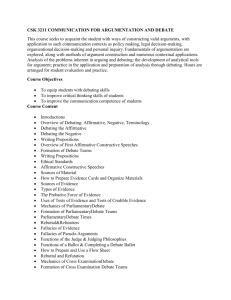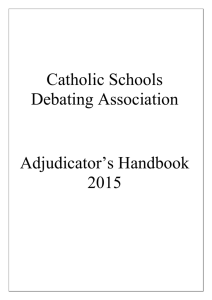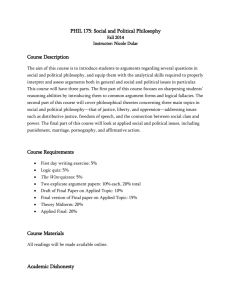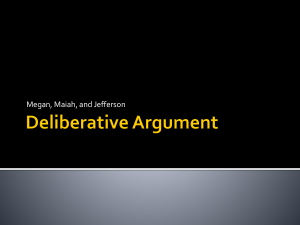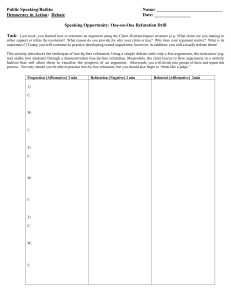Debater
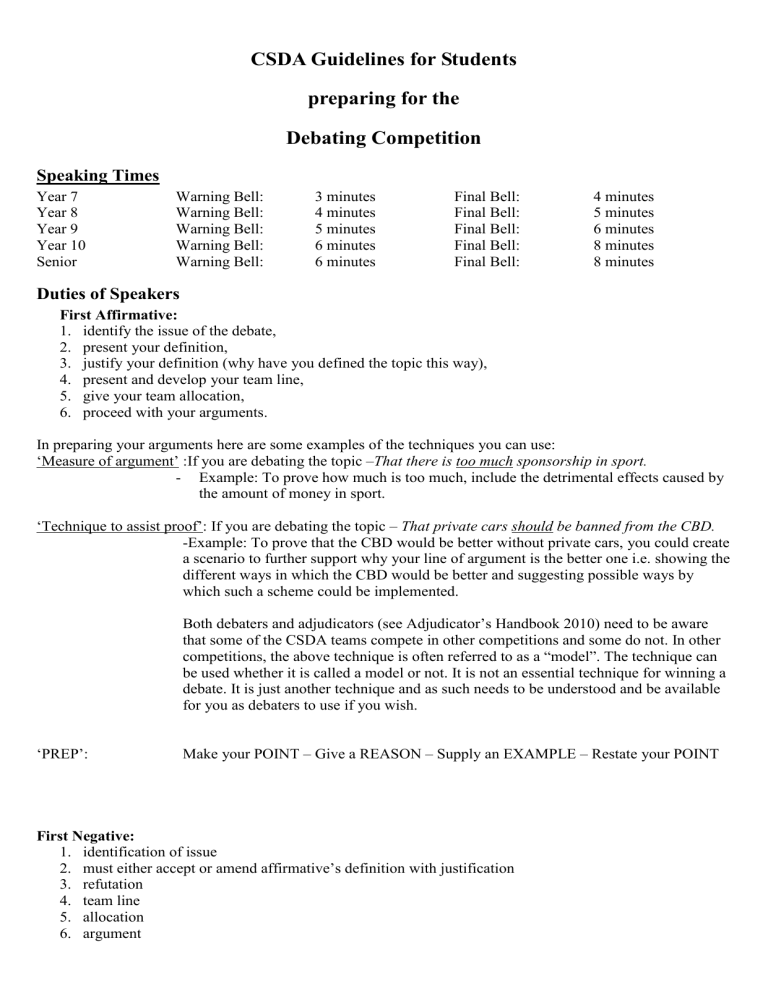
CSDA Guidelines for Students preparing for the
Debating Competition
Speaking Times
Year 7
Year 8
Year 9
Year 10
Senior
Warning Bell:
Warning Bell:
Warning Bell:
Warning Bell:
Warning Bell:
3 minutes
4 minutes
5 minutes
6 minutes
6 minutes
Final Bell:
Final Bell:
Final Bell:
Final Bell:
Final Bell:
4 minutes
5 minutes
6 minutes
8 minutes
8 minutes
Duties of Speakers
First Affirmative:
1.
identify the issue of the debate,
2.
present your definition,
3.
justify your definition (why have you defined the topic this way),
4.
present and develop your team line,
5.
give your team allocation,
6.
proceed with your arguments.
In preparing your arguments here are some examples of the techniques you can use:
‘Measure of argument’ :If you are debating the topic –
That there is too much sponsorship in sport.
Example: To prove how much is too much, include the detrimental effects caused by the amount of money in sport.
‘Technique to assist proof’: If you are debating the topic –
That private cars should be banned from the CBD.
-Example: To prove that the CBD would be better without private cars, you could create a scenario to further support why your line of argument is the better one i.e. showing the different ways in which the CBD would be better and suggesting possible ways by which such a scheme could be implemented.
Both debaters and adjudicators (see Adjudicator’s Handbook 2010) need to be aware that some of the CSDA teams compete in other competitions and some do not. In other competitions, the above technique is often referred to as a “model”. The technique can be used whether it is called a model or not. It is not an essential technique for winning a debate. It is just another technique and as such needs to be understood and be available for you as debaters to use if you wish.
‘PREP’: Make your POINT – Give a REASON – Supply an EXAMPLE – Restate your POINT
First Negative:
1.
identification of issue
2.
must either accept or amend affirmative’s definition with justification
3.
refutation
4.
team line
5.
allocation
6.
argument
Here are some important considerations for refutation:
-
Refutation is providing a counter argument that “destroys” the initial argument presented by a team.
It must be accompanied by a reason and/or example. It cannot simply be: “They said that there are no penguins in Antarctica, but they are wrong”….WHY? HOW?
Maybe your team has prepared a totally different definition and line of argument……..What do you do?....
You could say………- Our team firmly believes that our definition and line of argument is the more reasonable one BUT ‘EVEN IF’ we were to take up the affirmative’s definition and argument it is still wrong
BECAUSE……………………. You MUST provide adequate details.
If the affirmative creates a scenario (sometimes called a model) to assist them to prove their case, (mostly done
in a “should” debate), then the negative needs to refute each point of this scenario. Sometimes the negative will
choose to create a scenario of their own to assist them to refute the affirmative
Second Affirmative:
1.
deals with definitional issues
2.
presents refutation
3.
argues the case recapturing the initiative.
Second Negative:
1.
deals with definitional issues
2.
presents refutation
3.
argues the case recapturing the initiative.
Third Affirmative:
1.
presents refutation ( bulk of speech even to the 1 st bell)
2.
summarises own case
3.
contrasts it with other team’s case.
4.
SHOULD NOT INTRODUCE NEW MATERIAL.
Third Negative:
1.
as for Third Affirmative except…………
2.
new material MUST NOT be introduced.
Debates are often lost rather than won because speakers fail to discharge their duties. Every speaker must attempt to capture the initiative from the opposing team.
Questions to ask yourself and your team……….
As 1 st
Affirmative, have I explained why our definition is reasonable and fair?
As 1 st
Negative, have I accepted or rejected the affirmative’s definition? Have I explained my action?
Is our team line consistent? Does it answer the question of the topic?
As a team member, am I fulfilling my team role? Are the other members of my team fulfilling theirs?
What arguments is our team raising? Are they effective? Are they consistent?
Does our refutation attack ALL the important parts of the opposition’s case?
As 3 rd speaker, how much of our case still stands after the opposition’s refutation?
The following are the three areas that the adjudicator will be considering:
2
Matter : The content of a speech or what a speaker says. This includes: definition, team line, argument and refutation. She/he will watch for generalisations, unsupported opinions, hypothetical arguments, invalid arguments and personal attacks.
Manner
Method
:
:
The individual way in which a speaker presents material. This may include: “talking” to the audience instead of reading the whole speech, eye contact, use of language, varied use of voice, effective gesture, evidence of thinking on their feet, personality.
Remember that superior manner will not allow the adjudicator to ignore deficiencies in matter.
Organisation. Does each speaker complete her/his role? Do the individual speeches and the team’s material follow a logical sequence? Is refutation effective? Do team members use the available time appropriately? Does the team work together throughout the debate?
Remember that the result cannot be a draw. The result will be awarded on a significant aspect of the art of debating. Because a debate should be a conflict or argument it is reasonable that victory will be awarded to the team which has won the conflict, unless there are good reasons for not doing so.
Remember, debating must be a team effort. NO award will be given on the merits of any one speaker e.g. a brilliant 3 rd speaker. Remember also, that as debaters you are speakers, not readers.
Most importantly, enjoy your debating!!
3

